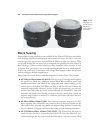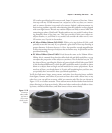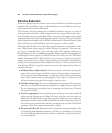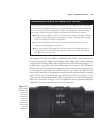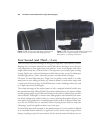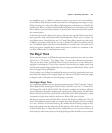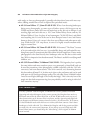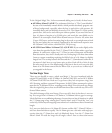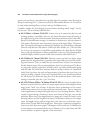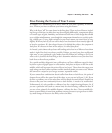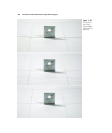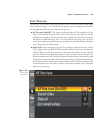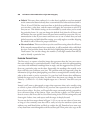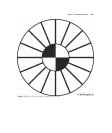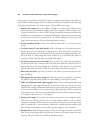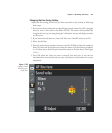pictures of, say, flowers, and when I am traveling light. For example, when shooting in
Europe I take along the 17-35mm lens (which is much smaller than the 14-24, and can
be used with polarizing filters, to boot), and my 28-200mm zoom.
Carefully consider the focal lengths you need before deciding which “magic” triad is
best for you. The new lineup looks like this:
■ AF-S Nikkor 14-24mm f/2.8G ED. I never cease to be amazed by this lens, and
its image quality is incredible, with very low barrel distortion (outward bowing at
the edges) and very little of the chromatic aberrations common to lenses this wide.
Because it has full-frame coverage, it’s immune to obsolescence. It focuses down to
10.8 inches, allowing for some interesting close-up/wide-angle effects. The down-
side? The outward curving front element precludes the use of most filters, although
I haven’t tried this lens with add-on Cokin-style filter holders yet. (The one from
Lee is very, very expensive.) Lack of filter compatibility isn’t a fatal flaw for D7000
users, as the use of polarizers would be problematic in any case. The polarizing effect
would be highly variable because of this lens’s extremely wide field of view.
■ AF-S Nikkor 24-70mm f/2.8G ED. This lens seems to provide even better image
quality than the legendary Beast, especially when used wide open or in flare-induc-
ing environments. (You can credit the new internal Nano Crystal Coat treatment
for that improvement.) My recommendation is that if you already own The Beast,
or can get one used for a good price ($1,000 or less), you don’t sacrifice much going
with the older 28-70mm lens, and may find the overlap with the 14-24mm lens
useful. But if you have the cash and opportunity to purchase this newer lens, you
won’t be making a mistake. Some were surprised when it was introduced without
the VR feature, but Nikon has kept the size of this useful lens down, while main-
taining a reasonable price for a “pro” level lens.
■ AF-S VR II Zoom-Nikkor 70-200mm f/2.8G IF-ED. Not a lot to be added about
the latest version of this lens, which is a worthy representative of the telephoto zoom
range in this “ideal” trio of lenses. It does have better performance in the corners
on full-frame cameras, but its other attributes remain the same. The one exception
is the magnification at long focal lengths and very close focusing distances. Due to
a quirk in optical design (common to many zoom lenses of this type, not just this
particular Nikon lens), the magnification or image size is much less when you’re
shooting subjects at focal lengths from about 150-200mm at distances of a couple
yards. You might end up with an image that is the same size, in the frame, as one
taken with a 135mm fixed focal length lens. That’s quite a reduction in magnifica-
tion, but it won’t affect most people. I do happen to shoot with my 70-200mm lens
at close distances and zoomed all the way to 200mm, so I’ve retained my old VR I
version and have no plans to upgrade to this newer lens.
David Busch’s Nikon D7000 Guide to Digital SLR Photography384



